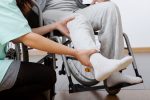‘Groundbreaking’ Cybernetic Therapy Improves Walking in SBMA


Two years of training with a wearable cyborg hybrid assistive limb (HAL), combined with leuprorelin therapy, markedly improved the walking abilities of a man with spinal and bulbar muscular atrophy (SBMA), a case study reports.
“This report describes the first successful case in the history of SBMA treatment in which the improvement and maintenance of ambulatory [walking] motor function were observed over [two] years,” the researchers wrote.
“Although this is only a single case report, the results are groundbreaking,” they said.
The case study, “The Combined Efficacy of a Two-Year Period of Cybernic Treatment With a Wearable Cyborg Hybrid-Assistive Limb and Leuprorelin Therapy in a Patient With Spinal and Bulbar Muscular Atrophy: A Case Report,” was published in Frontiers in Neurology.
SBMA, also called Kennedy’s disease, is a hereditary disorder marked by progressive weakness and atrophy (shrinkage) in the muscles closer to the trunk (proximal) and the bulbar muscles of the mouth and throat.
The disorder is caused by mutations in the androgen receptor (AR) gene, which encodes for the androgen receptor protein. This protein is enriched in motor neurons, the nerve cells responsible for controlling voluntary movements that are slowly lost in people with the condition.
Two SBMA treatments have recently been approved in Japan; the anti-androgen therapy leuprorelin acetate (leuprorelin) — which slows the progression of swallowing difficulties — and HAL.
HAL is a cybernetic unit that combines the function of humans, robots, and information systems. It’s designed to work as a part of its wearer’s body by responding to thoughts via interactive biofeedback (iBF). The HAL exercise system has been shown to improve walking in several neuromuscular diseases, including SBMA.
However, the long-term impact of combining leuprorelin and HAL has yet to be evaluated.
Researchers at the Niigata National Hospital, Japan describe the case of a 39-year-old man with SBMA who was treated with leuprorelin for a year, followed by HAL.
The man was diagnosed with SBMA when he was 29, but by 38 he had trouble climbing stairs without assistance. He began leuprorelin but after a year he noticed progressive limb weakness and HAL was started, which took place in a specialized rehabilitation facility.
An examination showed mild weakness in his mouth muscles, mild atrophy of the tongue, and a slight tremor in his upper limbs. There was mild weakness in the proximal muscles and he used a cane to walk long distances.
Walking exercise with HAL involved 20–30 minutes a day in one session for a total of nine HAL sessions in about two weeks with regular physiotherapy. Gait function was assessed by the two-minute walk test (2MWT), a measure of walk endurance, and the 10-minute walking test (10MWT) to determine speed. He continued leuprorelin therapy throughout the HAL training.
With one HAL therapy session, his walking ability improved significantly. Before HAL, he walked 111.5 meters in two minutes; after HAL, this increased to 134.2 meters. His walking speed also rose from 1.31 to 1.58 meters/second. Before HAL, his walking pattern showed unnatural swaying, but it decreased after the treatment, becoming more natural.
One month after HAL, even with self-training at home, both the 2MWT and the 10MWT test results worsened, although the results were still better than before HAL.
Regular treatment with HAL, together with leuprorelin, was continued every two months for two years.
Over 10 months of HAL, the walking tests steadily improved, which reached a peak of 177.3 meters in the 2MWT. From 18 months to two years, which involved 13 HAL sessions, the 2MWT was maintained between 165 and 178 meters. The 10MWT peak occurred before the 2MWR peak.
Over two years, the 2MWT improved 59.6% while the 10MWT increased 38.2%, demonstrating that the “walking endurance continued to improve with long-term cybernic treatment,” and “HAL appears to improve and maintain walking function,” the researchers wrote.
Blood tests revealed that after the first HAL session, the creatine kinase (CK) levels, a marker for neuromuscular damage, decreased. With continued HAL therapy, the CK levels gradually declined, corresponding to 2MWT improvements. His creatinine levels, a biomarker of muscle mass, were maintained.
“In this case report, the novel form of combined therapy overcame the apparent limitations of disease-modifying drugs acting on primary etiology [cause] and improved the gait function of patients with SBMA over the long term,” the authors concluded.
The post ‘Groundbreaking’ Cybernetic Therapy Improves Walking in SBMA appeared first on SMA News Today.


